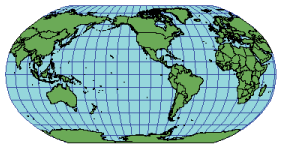Map projections and coordinate systems > Supported map projections
Robinson |
|
|
Release 9.2
Last modified August 3, 2007 |



Print all topics in : "Supported map projections" |
Description
Also called Orthophanic, Robinson is a compromise projection used for world maps.

Projection method
Pseudo cylindrical. Meridians are equally spaced and resemble elliptical arcs, concave toward the central meridian. The central meridian is a straight line 0.51 times the length of the equator. Parallels are equally spaced straight lines between 38° N and S; spacing decreases beyond these limits. The poles are 0.53 times the length of the equator. The projection is based on tabular coordinates instead of mathematical formulas.
Linear graticules
All parallels and the central meridian.
Properties
Shape
Shape distortion is very low within 45° of the origin and along the equator.
Area
Distortion is very low within 45° of the origin and along the equator.
Direction
Generally distorted.
Distance
Generally, scale is made true along latitudes 38° N and S. Scale is constant along any given latitude and for the latitude of the opposite sign.
Limitations
Neither conformal nor equal area. Useful only for world maps.
Uses and applications
Developed for use in general and thematic world maps.
Used by Rand McNally since the 1960s and by the National Geographic Society since 1988 for general and thematic world maps.
Parameters
Desktop
- False Easting
- False Northing
- Central Meridian
The Robinson_ArcInfo map projection is the same as the workstation version of the Robinson projection.
Workstation
- Longitude of Central Meridian
- False Easting (meters)
- False Northing (meters)